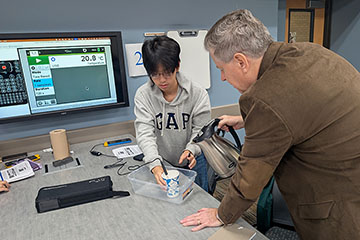CMU biology professors research population patterns of Great Lakes fish
Dr. Andrew McNaught and Dr. Tracy Galarowicz received a grant for their research on population patterns of Great Lakes fish.
Andrew McNaught, Ph.D., and Tracy Galarowicz, Ph.D. from the Biology Department, received a $223,665 grant for their project titled: Importance of Food Predators to Lake Whitefish and Cisco Recruitment. This study will look into whether changing food sources or predation explain the changing patterns of two larval fish species; Lake Whitefish are declining while Cisco are increasing in the nearshore areas (depths of < 10m) of the Great Lakes.
Nearshore areas are crucial for native fish. In the case of Lake Whitefish and Cisco, spawning, egg incubation, and larval stage development all take place in these nearshore zones. The populations of these fish have been fluctuating since the early 1900s, due to factors such as overfishing, predation, and a changing environment. Unfortunately, very little is known about the nearshore ecology of the Great Lakes, despite their potential to be greatly affected by stressors such as sedimentation, nutrient addition, pollution, and climate change.
In one portion of this study, doctoral student Kelly Hoyer is examining gut contents and growth rates of larval stage fish and comparing them to prey availability, as well as conducting laboratory experiments to determine foraging capabilities of larval Lake Whitefish and Cisco. Hoyer is also conducting predation trials with Round Goby and Rainbow Smelt, both of which are nearshore predators. These trials will determine if larval Lake Whitefish are more vulnerable than larval Cisco. In another aspect of the study, undergraduate student Julia Harig is conducting trials to determine if Lake Whitefish and Cisco are spending different amounts of energy on respiration. If larval Lake Whitefish expend more energy on respiration than larval Cisco, Whitefish will have less energy for daily activities such as foraging, predator evasion, and lead to slower growth rates.
This project began in March of 2020, but all field sampling had to be delayed due to the pandemic. Luckily, the project was able to be extended and the research has continued. The information gathered about food resources and predation will help fish biologists better manage the population of Lake Whitefish.
This story is brought to you by the Office of Research and Graduate Studies.




